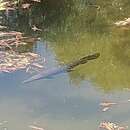Brief Summary
(
Inglês
)
fornecido por EOL authors
Tropical Gar (Atractosteus tropicus) may be found in the backwaters and slow moving sections of rivers, lakes, swamps, and shallow lagoons from southern Mexico to northern Costa Rica. They are often found in the warm stagnant waters of lowland areas and may be seen on the surface, where they resemble floating logs. Juvenile gar feed primarily at night, mainly or exclusively on other fishes, although plants and fruit have been reported as possibly part of the adult diet. Tropical Gar grow rapidly, reaching reproductive size at two years of age. Reproductively mature individuals enter shallow lakes at the beginning of the dry season to spawn. Some adults also reproduce in June and July when rains are heaviest and rivers flood their banks, creating excellent spawning habitat with flooded vegetation. Large schools of Tropical Gar deposit thousands of eggs in a gelatinous mass in the shallow waters. The adults return to the river, leaving the fry in the flooded vegetation. (Barrientos-Villalobos and Espinosa de los Monteros 2008 and references therein) In Mexico, Tropical Gar have been collected from the Coatzacoalcos River in Southern Veracruz to the Usumacinta River in the states of Tabasco and Chiapas. Isolated populations occur on the Pacific slope of Chiapas. In Central America, this species has been reported from Guatemala, El Salvador (Zanjón El Chino) and Nicaragua (Rio Negro, Lake Managua, and Lake Nicaragua). The southernmost known population inhabits the San Juan River and other small rivers in the Tortuguero National Park in Costa Rica. (Barrientos-Villalobos and Espinosa de los Monteros 2008 and references therein) In response to concerns about the loss of gar populations in Central America in the early 1980s, Costa Rica declared their populations at risk, but other countries have shown less concern. Tropical Gar remain among the main fish consumed by humans in Tabasco, Mexico. In at least parts of their range, Tropical Gar populations are declining, presumably due to some combination of habitat degradation and loss and overexploitation by fisheries. Genetic evidence suggests the possibility that there may be a distinct cryptic “Tropical Gar” species in Guatemala. (Barrientos-Villalobos and Espinosa de los Monteros 2008 and references therein) 43 Tropical Gar collected from Tabasco, Mexico, ranged in length from 270 to 680 mm. These 43 individuals harbored eight species of helminth parasites, including four trematodes, a cestode, and three nematodes. (Salgado-Maldonado et al 2004)
Diseases and Parasites
(
Inglês
)
fornecido por Fishbase
Cystoopsis Infestation. Parasitic infestations (protozoa, worms, etc.)
- licença
- cc-by-nc
- direitos autorais
- FishBase
Biology
(
Inglês
)
fornecido por Fishbase
Inhabit backwaters and slow moving sections of rivers and lakes. Often found in the warm stagnant waters of the lowland. Visible on the surface and resemble floating logs. Enter shallow lakes at the beginning of the dry season to spawn and known to reproduce also in June and July when rains are heaviest and rivers flood their banks providing an ideal spawning habitat of flooded vegetation. Large schools form to cast thousands of eggs in a gelatinous mass in the shallow waters. The adults return again to the river leaving the fry amongst the flooded vegetation (Ref. 36880). The eggs are poisonous to eat (Ref. 4537).
- licença
- cc-by-nc
- direitos autorais
- FishBase
Tropical gar
(
Inglês
)
fornecido por wikipedia EN
The tropical gar (Atractosteus tropicus) is a species of fish from Central America, where it is found in the Pacific and Atlantic drainages from southern Mexico to Costa Rica.[4] In Central America it is known as gaspar and in Mexico it is known as pejelagarto, a contraction of the words "pez" (fish) and "lagarto" (alligator). This gar inhabits a wide range of fresh and brackish water habitats such as rivers, floodplains, lakes and pools, but avoids areas with a strong current.[5] It reaches lengths of up to 1.25 m (4 ft) (although typically less than half that length) and a weight up to 2.9 kg (6.4 lb).[4] The tropical gar looks very similar to the longnose gar in color and markings, but can be distinguished by its shorter, broader snout. The tropical gar's diet consists mainly of cichlids and other fish.
While gar are not widely eaten, there is a traditional Tabasco dish of the same name that uses chili, limes, and salt to cook the animal.
Conventional and X-ray images
References

- licença
- cc-by-sa-3.0
- direitos autorais
- Wikipedia authors and editors
Tropical gar: Brief Summary
(
Inglês
)
fornecido por wikipedia EN
The tropical gar (Atractosteus tropicus) is a species of fish from Central America, where it is found in the Pacific and Atlantic drainages from southern Mexico to Costa Rica. In Central America it is known as gaspar and in Mexico it is known as pejelagarto, a contraction of the words "pez" (fish) and "lagarto" (alligator). This gar inhabits a wide range of fresh and brackish water habitats such as rivers, floodplains, lakes and pools, but avoids areas with a strong current. It reaches lengths of up to 1.25 m (4 ft) (although typically less than half that length) and a weight up to 2.9 kg (6.4 lb). The tropical gar looks very similar to the longnose gar in color and markings, but can be distinguished by its shorter, broader snout. The tropical gar's diet consists mainly of cichlids and other fish.
While gar are not widely eaten, there is a traditional Tabasco dish of the same name that uses chili, limes, and salt to cook the animal.


Conventional and X-ray images
- licença
- cc-by-sa-3.0
- direitos autorais
- Wikipedia authors and editors



 Conventional and X-ray images
Conventional and X-ray images